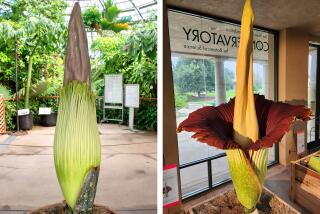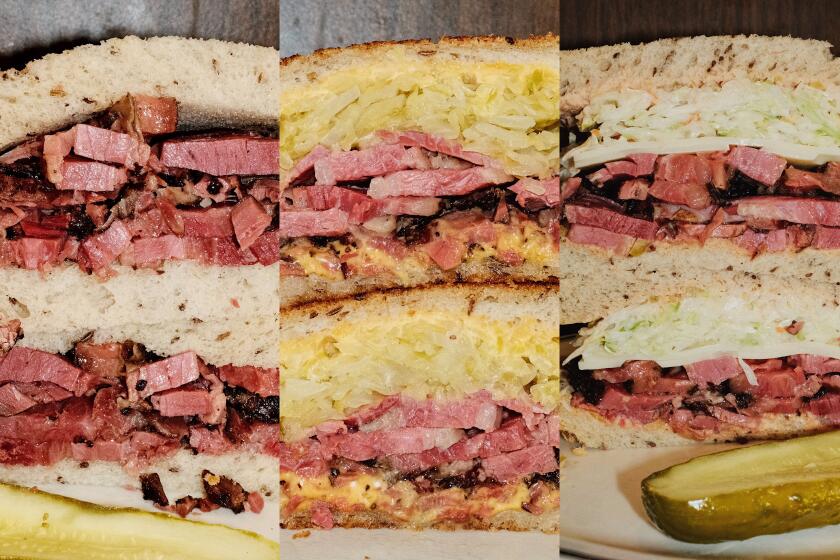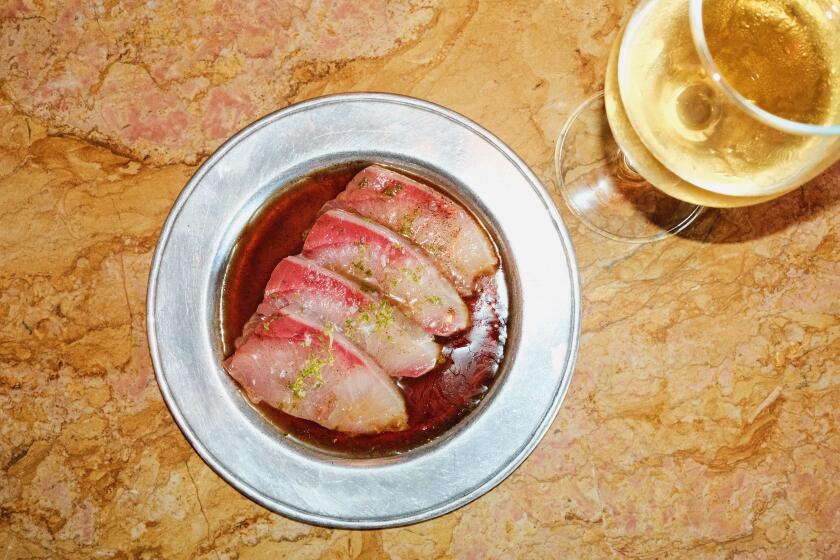Ode to the dandelion, jilted flower of spring
If the dandelion didn’t crop up in our lawns, we would call it a wildflower. If it did better in our vegetable gardens, we’d call it a salad leaf. If more people used it for folk cures, we’d call it a medicine. As it is, we call it a weed, and much of what is written about it concerns how to kill it.
Yet in spite of lawn culture, for the kitchen gardener the first dandelions of the season amount to a wink from nature, an ebullient signal that spring has sprung, salad season is here, and on its own terms.
Estimates of how many species of dandelion exist worldwide vary from 60 to 2,000. In the U.S., an as yet unpublished study by the Flora of North America Project will recognize 16 distinct species growing south of the Arctic and north of Mexico, from a San Bernardino County native so rare it’s on the endangered species list, to the common dandelion, or Taraxacum officinale.
The musical phonetics of the word dandelion are a kind of linguistic accident. It’s an Anglicization of the French dent de lion, or lion’s tooth, perhaps inspired by the serrated leaf edge. The late weed historian Larry Mitich guessed that the word arrived in England in the 11th century, with the Normans. Another French name, pissenlit, is occasionally found on restaurant menus; it means “wet the bed” and refers to mildly diuretic properties of the plant.
The wit fades away with the botanical name, Taraxacum. It is usually given as deriving from the Greek, and, according to Mrs. M. Grieve’s “A Modern Herbal,” breaks down to “disorder” and “remedy.” Mitich offered the Persian tarashqun, or bitter potherb, as another likely source.
For a plant that has always been half-crop, half-weed, the dandelion was always 100% edible. It had been so universally cultivated in Europe for so long — the greens for salads and frying, the root as a medicinal herb, the flower for wine — that by the time colonists arrived here, there was no telling where it came from, or even whether it arrived by design. It could have come as a crop, or stuck on the bottom of a founding father’s shoe. However the dandelion got here, it promptly got away.
Its architecture made it a first-class escape artist. The “flower” is actually a cluster of more than 100 tiny flowers called “ray florets.” As the florets mature, they drop away, leaving the parachute-like seeds poised on puffballs, waiting for a child’s breath or spring breeze to set a new crop.
As seeds drifted West, they sprouted most conspicuously in disrupted soil, colonizing freshly logged hillsides, along freeways, in housing starts. Studying the advance of the dandelion trail for the Department of Agriculture’s Rocky Mountain Research Station, Lora Esser established a fascinating profile of its role in the diets of wild animals. Sharp-tailed grouse in prairies ate seeds and flowers, she reported, while bighorn sheep, deer and grizzly bears ate the greens. Among domesticated animals, cattle, sheep and horses were all partial to it too, but some Coloradan elk and mule deer may have been ambivalent.
Had she looked at humans, Esser would have found a sadder story. Outside a select band of salad lovers, we Americans stubbornly refuse to partake. For the salad gardener, it is almost unbearable. If only we were as smart as Italians. If only we had the taste of grizzly bears.
The very qualities of the plant that drive lawn-proud homeowners nuts are what make it such a superb salad leaf. Dandelions are the first in the season to germinate. They then mine water and nutrients with a tapering tap root, while absorbing spring sunshine with broad, porous spreading leaves. The result of all their hard work is a vegetable that is not only delicious, but is a storehouse of iron, copper, potassium, calcium and magnesium.
For those who want to try their hands at farming the spinach of lawn weeds, one way to collect seeds is to walk in the park, plucking puff balls. However, seed companies claim to sell better varieties. Jim Johnson of the Mississippi-based Seedman company sells what he calls “Italian” dandelions, the same Taraxacum officinale as our yard weeds, but ones that he says produce three to four times the foliage. “You could go hungry picking the common dandelion,” he says.
To anticipate how best to grow dandelions, it helps to meet the family. Dandelions come from the Asteraceae, or sunflower, family. Its closest cousin among salads is endive. But in many ways, it has more in common with another tap-rooted relative with serrated leaves, the artichoke. Both species are cool-season vegetables that wilt easily and become tough and bitter late in the season. But dandelions are so much more delicate and have such fast hydraulics that the flower stalk bleeds latex if you pluck it.
Behaviorally, dandelions take after yet another cousin, the classic American sunflower. A spring day is well spent in the garden watching a dandelion tilt with perfect attentiveness as the sun crosses the sky. The flowers that open at dawn demurely fold up at dusk against the night chill. Why the dandelion should be such a graceful observer of the circadian clock, while other spring flowers such as the rose open and stay open, is anyone’s guess. For this exquisite ritual alone, the dandelion flower is every bit as poetic as the rose, but useless to flower arrangers. Cut the flower, and it curls up and dies before a vase has been filled with water.
As wrong as it feels, a salad gardener cultivating dandelions should always murder flowers as they appear, particularly if you live in burn zones or near open range with vulnerable native habitats. For those who plan to make wine, be sure to clip off all the green, keep just the florets and make sure the area hasn’t been sprayed with a pesticide.
A note about dandelion wine and all the “hey nonny no” folklore surrounding it: As the flowers steep in secret ingredients known only to the winemaker, they will indeed impart a floral quality to the drink, but you’ll need a recipe with sugar and fruit juice too. The legends about the dandelion florets being good for wine because they are brimming with nectar are either exaggerated or hooey, suspects Guy Nesom, a sunflower specialist at the Botanical Research Institute of Texas. Increasingly if not always, T. officinale flowers are apomictic, or self-fertile, he says. This means the plant is capable of setting seed without pollination and won’t produce nectar.
You won’t hear this from the lawn care industry, which argues that one reason we need to treat our lawns with its proprietary “weed and feed” mixes formulated with herbicides is to protect the bare feet of romping children from the stings of nectar-loving bees. To the mind of Tom Lanini, a weed scientist at UC Davis, a typical home lawn should not require herbicide to keep down dandelions. Healthy turf should crowd them out on its own. Far easier, cheaper and safer is to simply go out and pull the odd intruder, he says.
If you have been told that even a fragment of a root will regenerate, the good news is: It won’t, says Nesom. “Hit it below the top of the root or the growing point,” he says, “and you’ve got it.”
Hopefully you’ve then washed it, tossed it with bacon lardons and a sharp, mustardy vinaigrette. But as a kind of living calendar, leave a few dandelions in view of the picnic table. As the summer sun rises and the food on your plate changes from lettuce to tomatoes, the dandelions will shrivel back and disappear. Then one cool day in September, they will be back, harbingers of a balmy new salad season.
*
Resources
For nutritional information on raw and cooked dandelion greens, go to https://www.nal.usda.gov/fnic/foodcomp/search/index.html and type in “dandelion” as a keyword.
Seed sources include Seedman, 3421 Bream St., Gautier, MS 39553; (800) 336-2064 or (228) 497-6544; www.seedman.com.
More to Read
Eat your way across L.A.
Get our weekly Tasting Notes newsletter for reviews, news and more.
You may occasionally receive promotional content from the Los Angeles Times.










